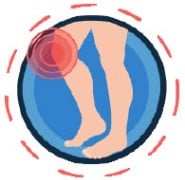Promoting Health for Older Adults

The increase in the number of older adults in the United States is unprecedented. In 2019, 54.1 million US adults were 65 or older, representing 16% of the population—or more than 1 in every 7 Americans. Nearly 1 in 4 older adults are members of a racial or ethnic minority group.
By 2040, the number of older adults is expected to reach 80.8 million. By 2060, it will reach 94.7 million, and older adults will make up nearly 25% of the US population.
Aging increases the risk of chronic diseases such as dementias, heart disease, type 2 diabetes, arthritis, and cancer. These are the nation’s leading drivers of illness, disability, death, and health care costs. The risk of Alzheimer’s disease and other dementias increases with age, and these conditions are most common in adults 65 and older. In 2021, health care and long-term care costs associated with Alzheimer’s and other dementias were $355 billion, making them some of the costliest conditions to society.
CDC’s National Center for Chronic Disease Prevention and Health Promotion funds partners to improve the health of older adults by:
- Helping those with dementia remain active, independent, and involved in their community as long as possible.
- Providing resources to help caregivers stay healthy and deliver quality care to their care recipients.
- Increasing early assessment and diagnosis, risk reduction, and prevention and management of chronic diseases for people with or at risk of Alzheimer’s disease and other dementias.
- Increasing the use of other clinical preventive services like blood pressure checks, cancer screenings, and blood sugar testing.
- Increasing the number of people who speak to a health care provider about their worsening memory.
- Providing the National Diabetes Prevention Program (National DPP) lifestyle change program to Medicare beneficiaries through CDC-recognized organizations to reduce the risk of type 2 diabetes.
- Promoting physical activity programs to reduce the risk of dementia and arthritis pain.

54.1 MILLION ADULTS
are 65 or older.

6.2 MILLION ADULTS
have Alzheimer’s disease.

11 MILLION PEOPLE
are unpaid caregivers to a person with Alzheimer’s disease.

27.2 MILLION ADULTS
aged 65 or older have arthritis.
CDC’s Approach

Alzheimer’s disease, the most common type of dementia, is an irreversible, progressive brain disease that affects over 6 million adults. It is the fifth leading cause of death for those aged 65 or older.
Alzheimer’s disease and other dementias slowly destroy the brain. They lead to cognitive declines, such as memory loss, language problems, or poor executive function, and functional declines, such as less ability to do daily activities and self-care. In some cases, dementias can lead to behavioral and personality changes, such as depression, paranoia, hallucinations, delusions, or agitation.
People with cognitive decline may find it hard to stay healthy or manage other chronic conditions. Early detection of cognitive decline, including Alzheimer’s and other dementias, provides an opportunity to manage other chronic health conditions and create health care plans.
Surveillance and Resources
CDC’s Alzheimer’s Disease and Healthy Aging Program works with partners and states to gather information on self-reported cognitive decline and caregiving among adults through the Behavioral Risk Factor Surveillance System (BRFSS). CDC developed an interactive data portal and a series of statistical briefs and infographics to help all users translate the data to action.
Healthy Brain Initiative and Public Health Road Maps
The Healthy Brain Initiative improves understanding of brain health as a central part of public health practice by:
- Creating and supporting partnerships.
- Collecting and reporting data for national objectives.
- Supporting populations with a high burden of Alzheimer’s disease and related dementias.
The initiative also promotes the use of the Healthy Brain Initiative Road Map Series: State and Local Public Health Partnerships to Address Dementia: The 2018–2023 Road Map and the Healthy Brain Initiative Road Map for Indian Country. These publications describe actions that state and local public health agencies and their partners can take to promote cognitive health, address cognitive impairment, and respond to the needs of caregivers.
Building Our Largest Dementia Infrastructure (BOLD)
The BOLD Infrastructure for Alzheimer’s Act became law on December 31, 2018. BOLD activities are designed to promote the use of CDC’s Healthy Brain Initiative Road Map Series to create a uniform national public health infrastructure to increase early detection and diagnosis, reduce risk, prevent hospitalizations, and support dementia caregivers.
The BOLD Act:
- Establishes Public Health Centers of Excellence for Alzheimer’s and related dementias.
- Supports public health departments to build the public health infrastructure for dementia.
- Increases data analysis and timely reporting of data by CDC.
In 2020, CDC funded the first three BOLD Public Health Centers of Excellence and 16 BOLD Public Health Programs. Seven additional BOLD Public Health Programs were funded in 2021 for a total of 23.

People are living longer in the United States, and dementia and other disabling chronic conditions are becoming more common. The need for caregivers, both unpaid (family and friends) and paid (professionals), will increase significantly as the population ages.
Although caregiving can be rewarding, caregivers are at risk of increased stress, depression, worse health, cognitive decline, and poor attention to their own health. Caregivers of people with dementia are at even higher risk, and they may delay dealing with their own health needs.
Unpaid caregivers provide most of the long-term and supportive care in people’s homes. According to 2015–2018 BRFSS data, about 20% of US adults aged 18 or older reported providing care or assistance to a person with a long-term illness or disability in the past 30 days. More than half of these caregivers help with personal care (such as bathing), and 4 in 5 manage household tasks such as finances or cleaning. In 2020, the value of this unpaid care for people with dementia was an estimated $257 billion.
CDC worked with partners to develop an action guide for using REACH OUT, an evidence-based intervention designed to promote health and well-being among people who care for someone with Alzheimer’s disease or dementia. CDC also created a guide for program developers, planners, and evaluators called Assuring Healthy Caregivers. A Public Health Approach to Translating Research into Practice: The RE-AIM Framework [PDF – 7.2 MB]
Clinical preventive services can prevent disease or find it early, when treatment is more effective. These services include:
- Screenings for chronic conditions such as cancer, high blood pressure, and type 2 diabetes.
- Immunizations for diseases such as flu and pneumonia.
- Counseling about personal health behaviors.
The US Preventive Services Task Force provides a complete list of all recommended services. CDC funds states, territories, and tribes to improve clinical preventive services by:
- Increasing chronic disease screening rates through the Colorectal Cancer Control Program, the National Breast and Cervical Cancer Early Detection Program, and the WISEWOMAN program (which screens women with low incomes and little or no health insurance aged 45 to 64 for heart disease and stroke risk factors).
- Working with health care organizations to identify people with prediabetes and refer them to CDC-recognized organizations that offer the National DPP lifestyle change program.
- Working with health systems to increase team-based care for patients with high blood pressure and high cholesterol.
In the United States, half of all adults aged 65 and older, or more than 27 million people, have arthritis.
CDC recognizes the following proven approaches to reduce arthritis symptoms:
- Participate in a self-management education program, such as the Chronic Disease Self-Management Program, that teaches the skills and confidence to live well with arthritis every day.
- Be active. Physical activity—such as walking, bicycling, and swimming—decreases arthritis pain and improves function, mood, and quality of life. Adults with arthritis should move more and sit less throughout the day. Getting at least 150 minutes of moderate-intensity physical activity each week is recommended. However, any physical activity is better than none. CDC-recognized physical activity programs can improve health for participants with arthritis.
- Maintain a healthy weight. People can reduce their risk of knee osteoarthritis by controlling their weight.
- Protect your joints. People can help prevent osteoarthritis by avoiding activities that are more likely to cause joint injuries.
Talk with a doctor. Recommendations from health care providers can motivate people to be physically active and join a self-management education program. People with inflammatory arthritis, such as rheumatoid arthritis, have a better quality of life if they are diagnosed early, receive treatment, and learn how to manage their condition.